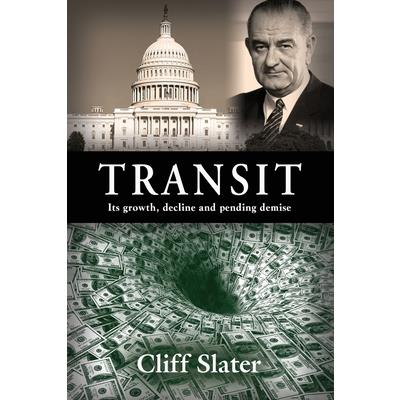Transit
-
9折 1227元
1363元
-
 預計最高可得金幣60點
?
可100%折抵
預計最高可得金幣60點
?
可100%折抵
活動加倍另計 -
HAPPY GO享100累1點 4點抵1元 折抵無上限
-
分類:英文書>生活風格>汽機車情報>汽車追蹤? 追蹤分類後,您會在第一時間收到分類新品通知。
- 作者: Cliff,Slater 追蹤 ? 追蹤作者後,您會在第一時間收到作者新書通知。
- 出版社: Booklocker.com 追蹤 ? 追蹤出版社後,您會在第一時間收到出版社新書通知。
- 出版日:2023/12/29
活動訊息
內容簡介
Cliff Slater spent 30 years fighting rail transit projects. Needing to know more than his opponents about transit, he gained a different view of what caused it to accrue two trillion dollars in subsidies since 1975, versus none before then.
Rail transit in America was initially the product of innovative private enterprise. But by 1960, rail transit was almost wholly publicly owned and heavily subsidized.
The nation's 1,150 transit bus systems were still largely private and profitable in 1960, but by 1983, municipal governments had taken over the entire transit bus industry.
Despite the subsidies, there has been a marked deterioration in the condition of the nation's transit infrastructure. The American Society of Civil Engineers tells us that: "a backlog of $176 billion for transit investments has emerged and is expected to grow to nearly $250 billion through 2029."
This book explains to students and others what our municipal, state, and federal governments have been changing, especially during the last 60 years, to bring us to this point. If we can understand how it happened, we can intelligently discuss what needs remedying.
This book is also the story of what happens when a private industry is socialized and unharnessed from the disciplines of the marketplace. Originally, America's transit systems earned their incomes by satisfying the needs of their customers, whereas transit today is about adjusting to the agendas of bureaucrats, politicians, and special interest groups.
The socialization of the transit industry resulted from the Urban Mass Transportation Act of 1964 and its subsequent amendments. Little was written about the academics and politicians who opposed the act, and how correctly they forecast the outcome for transit. This book tells their story.
The book also tells how President John F. Kennedy in 1962 defined what transit needed in new legislation, and how the Urban Mass Transportation Act of 1964 that President Lyndon Baines Johnson signed was the antithesis of Kennedy's recommendations and set the stage for a public-transit takeover. The final action was President Richard Nixon's surprising 1970 political effort that resulted in $10 billion in funding for the 1964 Act.
When the transit data from the period known as the Great Inflation, 1965 to 1982, is adjusted for inflation, we see a different picture of what happened compared to the conventional history.
This then is the story about the rise and decline of transit in the U.S from 1831 to today. We also discuss possible futures for transit. We examine private sector successes such as the Atlantic City Jitney Association, profitable for over 100 years, Uber and Lyft in the modern era; the potential impact of autonomous vehicles; and the long-term effects of the COVID pandemic. We discuss why the impact of all this on transit, as we know it, is likely to lead to its demise.
配送方式
-
台灣
- 國內宅配:本島、離島
-
到店取貨:
不限金額免運費



-
海外
- 國際快遞:全球
-
港澳店取:


訂購/退換貨須知
加入金石堂 LINE 官方帳號『完成綁定』,隨時掌握出貨動態:
商品運送說明:
- 本公司所提供的產品配送區域範圍目前僅限台灣本島。注意!收件地址請勿為郵政信箱。
- 商品將由廠商透過貨運或是郵局寄送。消費者訂購之商品若無法送達,經電話或 E-mail無法聯繫逾三天者,本公司將取消該筆訂單,並且全額退款。
- 當廠商出貨後,您會收到E-mail出貨通知,您也可透過【訂單查詢】確認出貨情況。
- 產品顏色可能會因網頁呈現與拍攝關係產生色差,圖片僅供參考,商品依實際供貨樣式為準。
- 如果是大型商品(如:傢俱、床墊、家電、運動器材等)及需安裝商品,請依商品頁面說明為主。訂單完成收款確認後,出貨廠商將會和您聯繫確認相關配送等細節。
- 偏遠地區、樓層費及其它加價費用,皆由廠商於約定配送時一併告知,廠商將保留出貨與否的權利。
提醒您!!
金石堂及銀行均不會請您操作ATM! 如接獲電話要求您前往ATM提款機,請不要聽從指示,以免受騙上當!
退換貨須知:
**提醒您,鑑賞期不等於試用期,退回商品須為全新狀態**
-
依據「消費者保護法」第19條及行政院消費者保護處公告之「通訊交易解除權合理例外情事適用準則」,以下商品購買後,除商品本身有瑕疵外,將不提供7天的猶豫期:
- 易於腐敗、保存期限較短或解約時即將逾期。(如:生鮮食品)
- 依消費者要求所為之客製化給付。(客製化商品)
- 報紙、期刊或雜誌。(含MOOK、外文雜誌)
- 經消費者拆封之影音商品或電腦軟體。
- 非以有形媒介提供之數位內容或一經提供即為完成之線上服務,經消費者事先同意始提供。(如:電子書、電子雜誌、下載版軟體、虛擬商品…等)
- 已拆封之個人衛生用品。(如:內衣褲、刮鬍刀、除毛刀…等)
- 若非上列種類商品,均享有到貨7天的猶豫期(含例假日)。
- 辦理退換貨時,商品(組合商品恕無法接受單獨退貨)必須是您收到商品時的原始狀態(包含商品本體、配件、贈品、保證書、所有附隨資料文件及原廠內外包裝…等),請勿直接使用原廠包裝寄送,或於原廠包裝上黏貼紙張或書寫文字。
- 退回商品若無法回復原狀,將請您負擔回復原狀所需費用,嚴重時將影響您的退貨權益。












商品評價